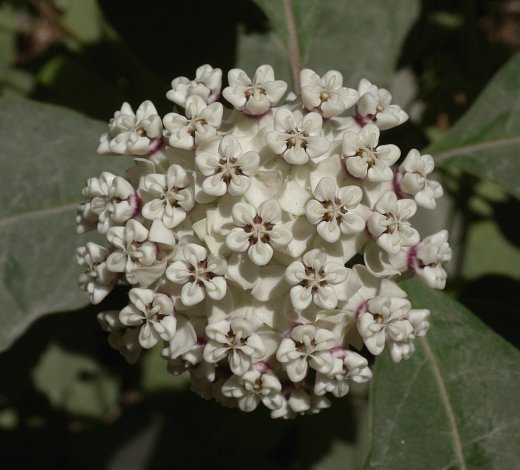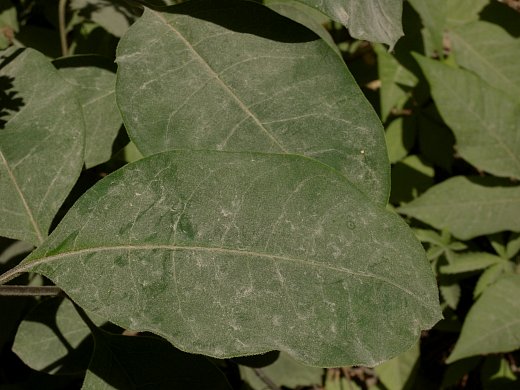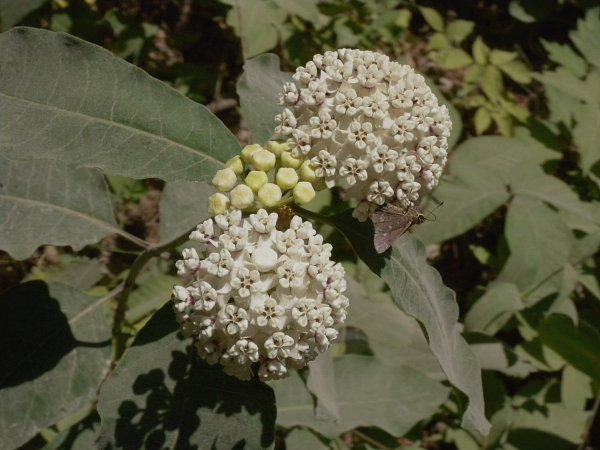
Each flower spans about 8-10 mm. across, consisting of a short light green calyx with 5 teeth, 5 white petals, a corona with 5 white hoods, and a short central column containing the reproductive organs. Each flower usually has a narrow purple ring between the petals and the corona. The petals are obovate in shape and 6-8 mm. long; they are widely spreading to drooping. Each hood (about 4-5 mm. in length) contains an exerted slender horn that bends toward the center of the flower. The pedicels of the flowers are about 1-1½" long, light green to pale purplish green, and finely pubescent. The blooming period occurs from late spring to early summer, lasting about 3-4 weeks. The flowers are fragrant. Cross-pollinated flowers are replaced by lanceoloid seedpods (follicles) about 4-5" long and ¾" across; their outer surfaces are smooth and downy. During the late summer or fall, each seedpod splits open along one side to release its seeds. The seeds have tufts of white hair and they are distributed by the wind. The rhizomatous root system can produce small colonies of clonal plants.
Cultivation: The preference is partial sun to light shade, dry-mesic conditions, and soil containing clay-loam, loam, or rocky material. Most growth and development occurs during the spring after the danger of hard frost has passed.

Range & Habitat: The native White Milkweed is occasional in southern Illinois, while in the rest of the state it is absent (see Distribution Map). Illinois lies along the NW range limit of this species. Habitats include upland savannas, barren rocky bluffs, upland rocky woodlands, wooded hillsides, rocky banks of streams, and woodland edges along roadsides. Occasional wildfires and other kinds of disturbance are beneficial if they reduce competition from woody vegetation. This wildflower is found in average to high quality natural areas.
Faunal Associations: Little is known specifically about the floral-faunal relationships of White Milkweed, although it is probably similar to other milkweeds that are found in wooded areas. The nectar of the showy flowers attracts butterflies, skippers, and possibly moths; other likely floral visitors include various long-tongued bees and wasps. The Insect Table lists the various species that feed on the foliage, stems, plant juices, and other parts of milkweeds. White Milkweed is one of the food plants for the caterpillars of the Monarch butterfly (Danaus plexippus). Because the bitter white sap of the foliage contains toxic cardiac glycosides, it is avoided by mammalian herbivores.
Photographic Location: A woodland border along a dusty gravel road. The leaves of the photographed plants would appear more green, but they are covered by a layer of dust that was generated by passing motor vehicles.

Comments: This milkweed has very showy flowers and it should be cultivated more often. The flowers are mostly white, except for a narrow purple ring between the petals and the hooded corona. This is the source of another common name, 'Red-Ring Milkweed.' Illinois has several native species of milkweed with white flowers, although most of these have rather restricted ranges within the state. A species that is found in northern Illinois, Asclepias ovalifolia (Oval-Leaved Milkweed), has flowers and leaves that are similar in appearance to those of White Milkweed. However, Oval-Leaved Milkweed is a smaller plant (typically only ¾-1½' tall) and its leaves are more pubescent. Another northern species with white flowers, Asclepias lanuginosa (Woolly Milkweed), has stems with spreading hairs and its leaves are more narrow. A third species, Asclepias perennis (Swamp White Milkweed), also has more narrow leaves and its umbels of flowers are more flat-topped. This latter species also occurs in southern Illinois, but it is found in more soggy habitats such as swamps. Another white-flowered species, Asclepias verticillata (Whorled Milkweed), has a very different appearance from the preceding species because of its whorls of narrowly linear leaves.